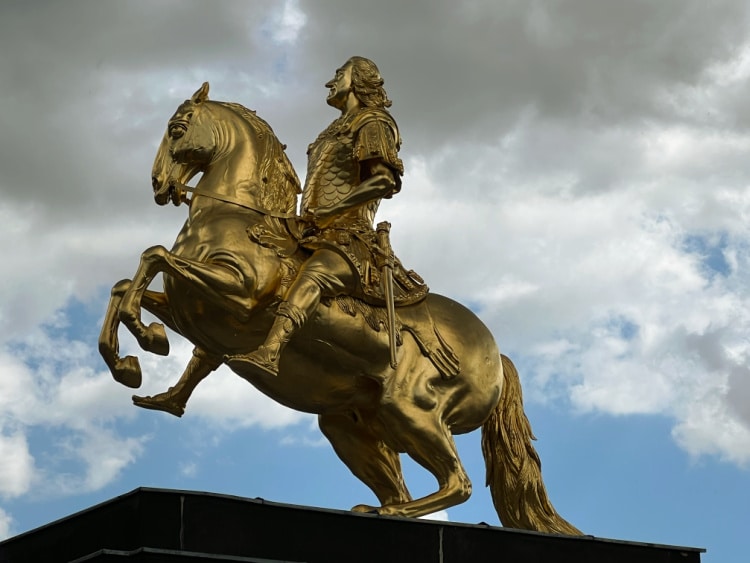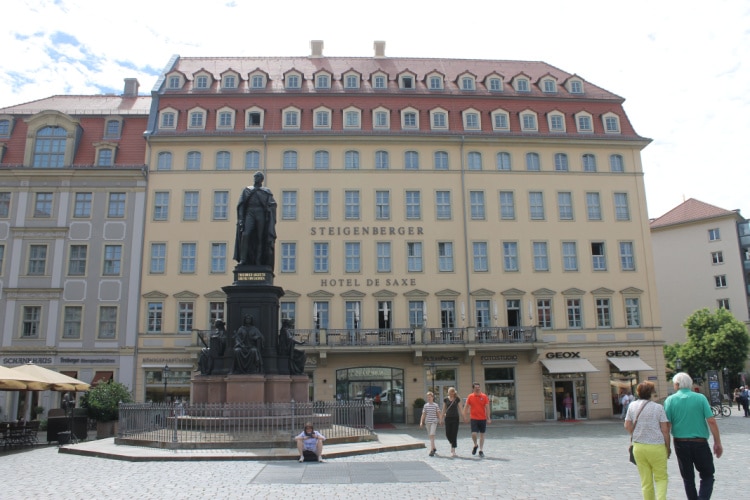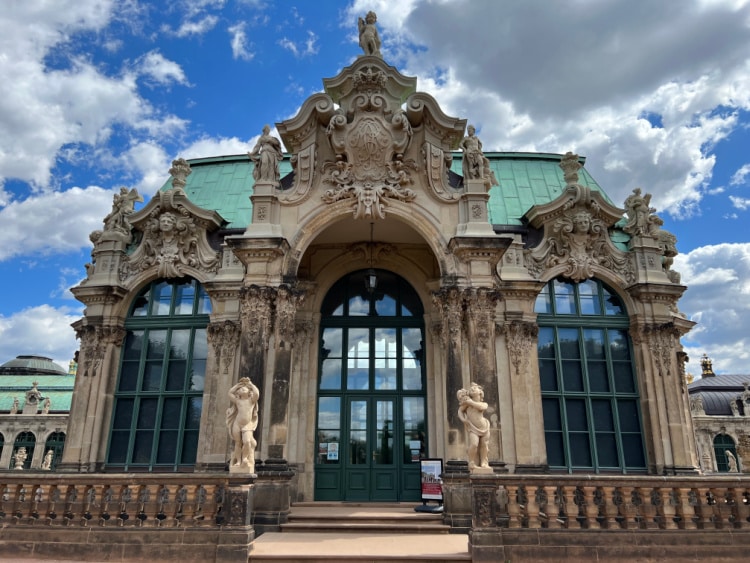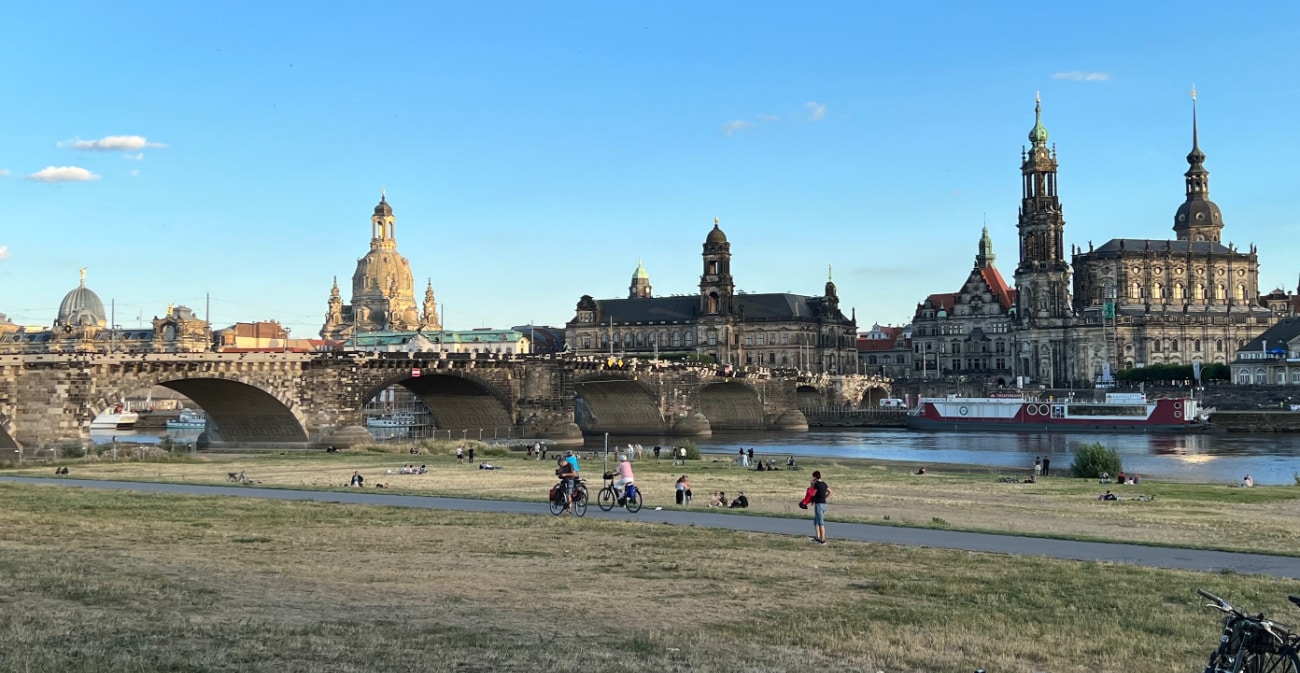Dresden is Baroque on steroids. Easily recognizable by the presence of a “putto,” a cherubic baby, the Baroque style dominated in the late 1600s, just as King Augustus II the Strong, took the throne of Saxony and decided his capital city needed a makeover to rise from his perceived “wallflower status.” And promptly overcompensated, why not? If one naked baby was good, 1000 had to be transcendental. Drenched in naked babies, singing, dancing, and even playing with a beehive (I can’t imagine that ending well), it’s like someone splattered a nursery all over Dresden. Then again, this monarch supposedly fathered well over 300 children. Perhaps there’s a theme in these Dresden highlights?
But Augustus got the prominence he wanted. Nicknamed the “Florence on the Elbe,” Dresden became a nexus of art, technology, and forward-thinking, even when Saxony ceased being a duchy in its own right and became a part of Germany. Bombed upside-down in WWII, Dresden’s architectural opulence was reduced to smithereens. Despite this misfortune, it became one of the first cities to be restored. Using the original schematics and even stone from the original quarries, modern architects ensured Dresden 2.0 looks just like Dresden 1.0 down to every last naked baby. And it’s gorgeous.

Glory Reborn
Sitting down to breakfast on the balcony of the ultimate status address of Steinenberger Hotel de Saxe, I watched as the sun swept over the Neumarkt Plaza. The epic dome of the Frauenkirche Cathedral drew up its shadows with the light. Embedded in the Aldtstadt — the old part of town – the cathedral emerges as the eyecatcher of the plaza. The interior displays a mix of statuary and pastels. However, that day my goal focused on another plaza and another eyecatcher.
The Cathedral of the Holy Trinity, the House of Estate, and Dresden Castle represent the architectural power-throuple of the city. The manganese in their stonework has oxidized each building almost entirely black and, seen from the Schloßplatz (Castle Square), they form a visual salvo of Saxon majesty.
The stout House of Estates retains its original function as the city council building. Similarly, Holy Trinity remains the Catholic seat of Dresden, despite being remarkably small. But what it lacks in footprint, the cathedral makes up for in architectural fluidity, looking like it had been poured into shape. Its fanciful exterior belies a somewhat restrained white interior; most of the color is reserved for the altar painting of Jesus.

The Dazzling Dresden Castle
But whereas the House of Estates and cathedral came out of WWII more or less intact, Dresden Castle became a bombed-out shell. Moreover, it remained so during the East German regime. My guide, Thomas, recalled playing games amid the ruins of the palace as a child. It was only after German reunification in 1990 that restoration began in earnest. It continues to this day. Augustus II himself would be impressed with the work. His collection of art, one of the biggest in Europe, survived the Stürm und Drang unscathed and was lovingly reinstalled. Now a museum, the Palace has the “Sleeping Venus” by Giorgione, one of the most famous paintings of the goddess.
The castle is impressive outside and in. The exterior is dominated by the Fürestenzug, a 335-foot life-sized procession of Wettin Margraves, Electors, Dukes, and Kings going back to 1127. Framed by fierce giants, the gateway arch leaves no doubt as to who was in charge. Prestige architecture reveals power as much as wealth.
And then there’s the Zwinger, and nowhere does “Dresden baroque” hit its stride harder. There are naked babies on every corner of the balustrade. Nymphs in every grotto. Like the altar in Holy Trinity, the Zwinger held my gaze and did. Not. Let. Go. Set off by Crown Gate, whose onion dome looks like a cake you would serve to a Disney princess, the Zwinger is, on blueprints, just the showgrounds of Dresden Castle; in reality, it was Augustus II trying to outdo Versailles. Essentially, the Zwinger is what happens when an architect is given an unlimited budget and the 17th century equivalent of a BeDazzler.

Gute Nacht
Across the Elbe River lies the Neustadt, or the new part of town. Several lofty institutions including the Japanese Palace and the Dresden Art House exist here along with proud residents. However, the two neighborhoods exude distinctly opposite vibes. If the Aldtstadt touts about culture, the Neustadt embraces counter-culture. It goes without saying that Neustadt boasts the nightlife. And this being Germany, this inevitably involves a good brew.
While I’ve had bratwurst and beer before, nothing beats having them in their native habitat. I suggest Louisengarten, the best beer garden in the city. In fact, it was at Louisengarten that it dawned on me that German food and drink evolved together to bring out each other’s best. It should come as no surprise that Dresden, a cultural capital for 400 years, should extend that same passion to its cuisine — and in some particularly modern ways. Eateries like Lila Soße focus on sustainable and organic cuisine.
Berlin (techno) and Münich (Oktoberfest) may lure the international crowd. But Dresden remains a favorite among Germans. The uptick? Dresden isn’t drowned in tourists. And, no kitsch gets in the way of all the grandeur. Always on the market for authenticity, I found that Dresden checked every box.
The country code for Germany is 49.
[alert type=white]
Where To Stay:
Steinenberger Hotel de Saxe: Smackdab in the Aldstadt, the Steinenberger is pure sophistication. +49 351 43860; www.steigenberger.com
Pullman Hotel: Within walking distance of the main train station, the Pullman is also within easy reach of the Aldstadt. +49 351 4814109; www.pullman-hotel-dresden.de
Where to Eat:
Louisengarten: Suds and sausage; what’s not to like? +49 (0) 160 7965137; www.biergarten-dresden.de
Brenn Nessel: In one of the oldest buildings in Dresden, this eatery has German cuisine with a modern twist. +49 351 21789068; www.brennnessel-dresden.de
Lila Soße: Food that is all sustainable, all organic. +49 0 351 8036723; www.lilasosse.de
What To Do:
Dresden walking tour: Get a tour from a native. +49 1763 9118855; www.showme-around.de
Grosser Garten: Dresden’s answer to Central Park, with prettier buildings. www.grosser-garten-dresden.de
Royal Palace: Once a place of kings, now a kingly museum. +49 (0) 351 4914-2000; www.schloesserland-sachsen.de
[/alert]

